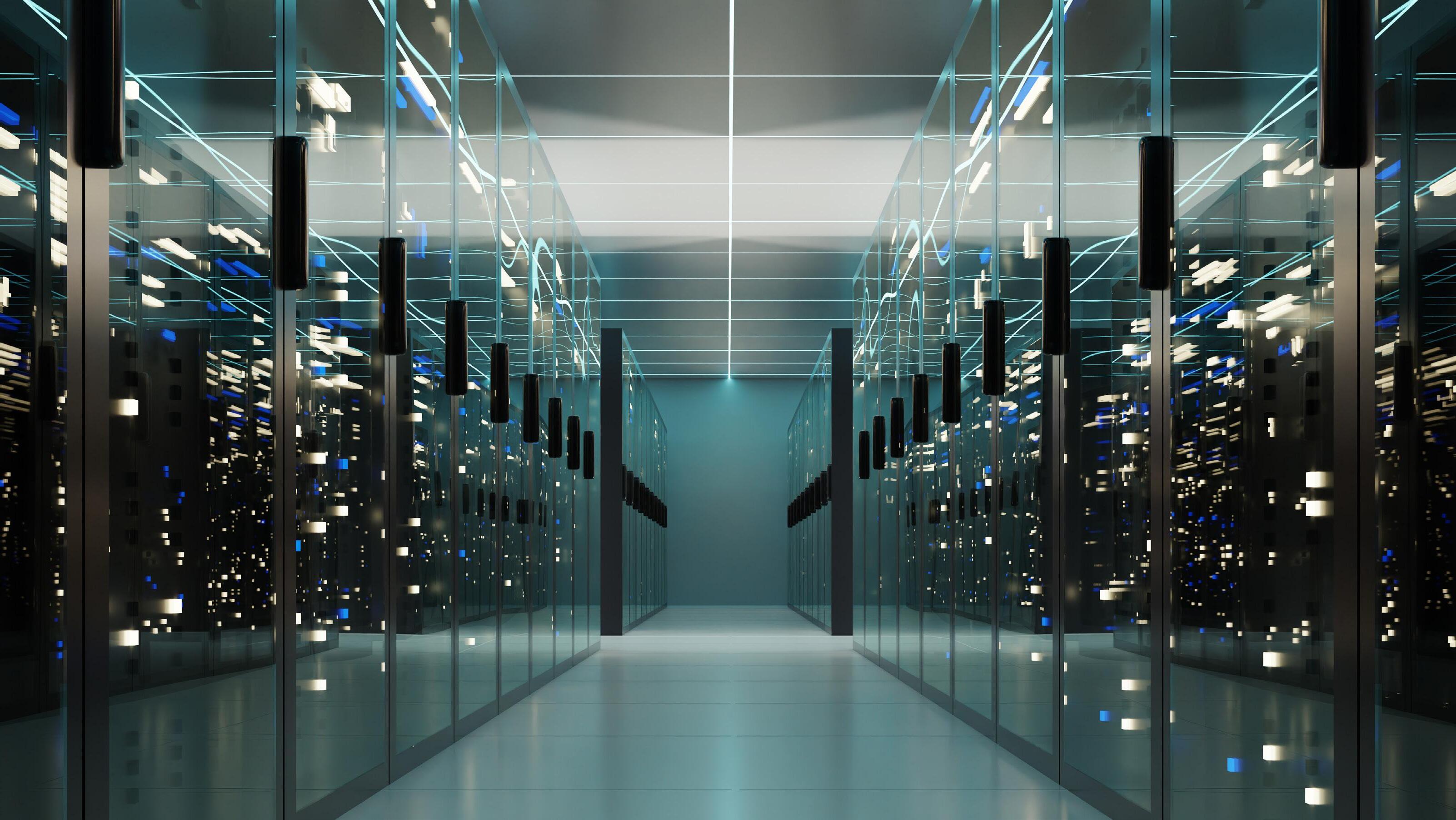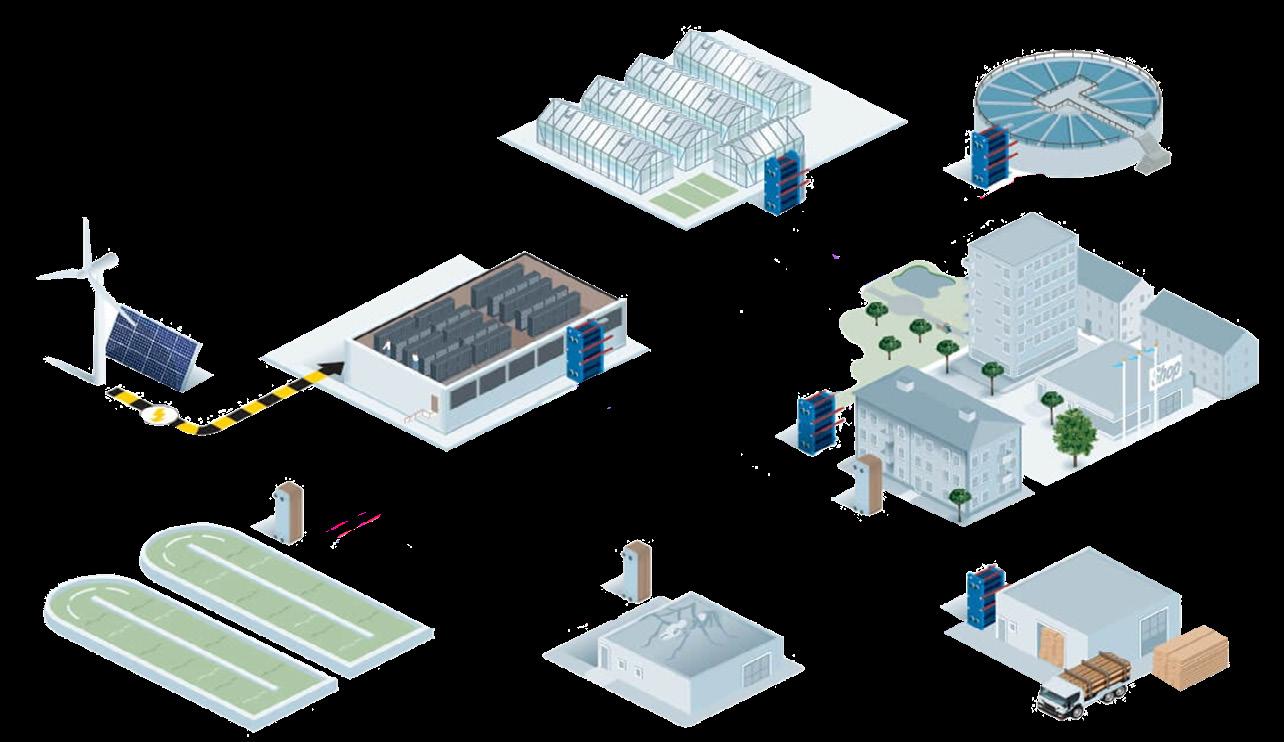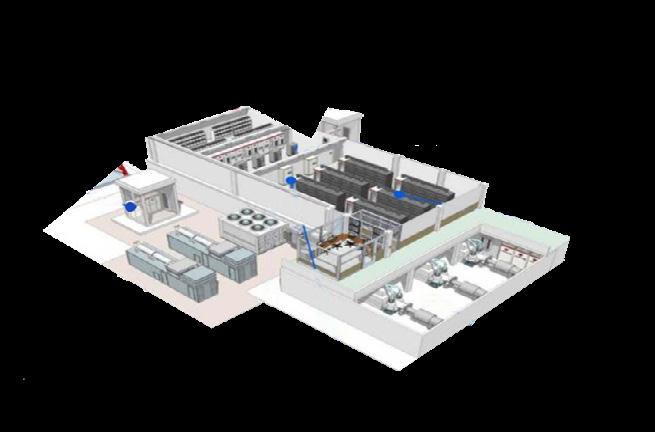
Decarbonizing the backbone of the internet
Redefining data center effectiveness for a net zero world
Data center demand is growing with AI, content streaming, mobile devices, distributed work, and the overall increases in speed that make up the backbone of the world’s nervous system.
As the digital age accelerates, data centers have become pivotal in sustaining the growth of AI, content streaming, mobile connectivity, and the ubiquitous presence of distributed workforces.
The exponential expansion of the digital universe has drastically reshaped our world and our interaction with technology. In the face of burgeoning global demand, the reliance on increased data transfer, storage, and processing capabilities the infrastructure that underpins our digital lives is rapidly evolving. The capacity of the worlds data centers has doubled since 2015, with projections indicating a further doubling by 2030.
This evolution is marked by an unmistakable trend from local ‘on premises’ resources towards hyperscale facilities offering cloud services and co-location sites hosting the data and systems of many organisations. In tandem with hyperscale consolidation, “Edge data centers” have become a focal point in the data center landscape. These facilities are smaller yet integral components of the data distribution network, positioned closer to end-users to deliver content and services with minimal latency.
The growth of edge computing is propelled by the escalating demand for real-time data processing, which is essential for a plethora of applications, from immersive streaming experiences to the intricacies of smart city ecosystems.
Growth in the data center market is therefore characterized by twin trends, a move to scale with consolidation in new buildings often more than 100,000m2 in size and a focus on location, with strategic placement of smaller, sub-5,000m2, facilities in key nodes within our urban fabric.
As the capabilities of these centers expand, so too does the need to reevaluate their environmental footprint. The same urgency driving the development of AI, streaming, and IoT solutions must be directed toward making data centers sustainable—integrating green energy sources, optimizing resource use, and employing innovative cooling and heat recovery technologies. In essence, as we sculpt the nervous system of the future, we must ensure it is not only swift and smart but also responsible and resilient.

The data center sector has a huge and growing demand for resources globally
8,000
>120M
mtCO2e of embodied carbon emissions annually by 2030
Data centers globally $222B
Global energy use
Data center spending in 2023 90% of all data centers are in 5 countries 1%-2%
240-340TWh
Energy use annually*
3 * (excluding energy use for mining of crypto currencies, estimated at a further 120TWh per year)
The growth of the digital world has changed our planet and our ability to harness technology.

As we approach 2028, forecasts suggest that internet users will near 8.4 billion—equivalent to the earth’s anticipated population, marking a significant leap from the 64% global internet penetration rate seen in 2023. This universal connectivity signals a new era of digital inclusivity but also introduces critical challenges in terms of environmental sustainability with data centers already responsible for 240-340TWh of electricity consumption (excluding 120TWh linked to mining of crypto currencies). This is well over 1% of global energy demand (IEA, 2024). Furthermore, data centers’ total energy may exceed 1,000TWh by 2026 due to growing demand and and growth in energy intensive AI services and crypto mining.
Beyond the sheer quantity of energy use, there are several important sustainability implications of growth in the data center sector. We estimate that the embodied carbon associated with construction of new data centers could reach 88 million tonnes CO2e by 2030, while the heat wasted from existing centers could meet the needs of over 13 million homes. Critically, traditional measures of data center efficiency, such as Power Usage Effectiveness (PUE), while foundational and impactful, no longer suffice. Consequently, the scale of impact and associated opportunities for reimagining data center performance are underappreciated.
To align with the next phase of data center evolution, a broader set of metrics must be considered, focusing on holistic environmental impacts and the push towards sustainable, lowcarbon outcomes.
There is an urgent need to rethink the metrics by which we judge data center performance.
Metrics like Total Power Use Effectiveness (TUE) build upon PUE, factoring in the non-processor power loads increasingly integrated within server racks. Energy Reuse Factor (ERF) measures how much energy input into data centers is
beneficially repurposed, often as low-grade heat, encouraging a symbiotic relationship between these facilities and the communities they serve. The Renewable Energy Factor (REF) quantifies the extent to which data centers use direct renewable or zero-carbon energy sources. Additionally, Water Use Effectiveness (WUE) and Carbon Use Effectiveness (CUE) provide insights into water usage and net carbon impacts per unit of processing power.
The adoption of these new benchmarks is imperative. By doing so, we enable data center designers, customers, operators, and regulators to make informed, environmentally conscious decisions. Those data centers that meet these criteria can then be recognized and rewarded in the marketplace, incentivizing a shift towards greener practices.
As the data center sector continues to expand, it stands at the forefront of demanding and fostering the development and adoption of low-carbon construction materials and practices. This magnitude of growth represents an unprecedented opportunity to serve as a catalyst for reducing the construction industry’s carbon footprint, ultimately contributing to global netzero ambitions.
By integrating waste heat recovery and adaptive reuse, data centers can exemplify circular economy principles— eliminating waste through the recycling of heat and repurposing existing structures. The transition to these new measures and benchmarks is not merely an operational upgrade but a reimagining of data center industry success. Embedding these metrics into the industry standard will ensure the digital world’s growth is not at odds with our planet’s health, setting the course for a sustainable digital age.
4
IEA, 2024. Electricity 2024 - Analysis and forecast to 2026.
Energy growth in data centers in the USA
Data centers use more electricity than entire countries Energy demand in data centers worldwide from 2015 to 2021, by type (in terawatt hours) Domestic
Source: Enerdata, IEA
Source: IEA Statista 2023
5 0 50 100 150 200
2015 2016 2017 2018 2019 2020 2021
electricity consumption of
2020 in TWh Nigeria 29 73 124 153 208 200 - 250 266 286 Colombia Argentina Egypt South Africa Indonesia UK Data Centers Traditional Cloud (non-hyperscale) Hyperscale Additional Information: Worldwide; 2015 to 2019 Traditional Cloud (non-hyperscale) Hyperscale
selected countries vs. data centers in
Almost all the processing energy for data centers is transformed to heat. The bene f icial use of this wasted heat represents a signi f icant opportunity for GHG emissions reduction in data centers and surrounding buildings.
In the rapidly expanding digital economy, data centers have emerged as critical infrastructure. However, they are also among the largest consumers of energy, with nearly all the power they consume for processing ultimately dissipated as heat. This represents a considerable inefficiency and a source of greenhouse gas (GHG) emissions. Yet, this waste heat also presents a significant opportunity for innovation and sustainability.
Typically, over 99% of the electricity consumed by data centers is transformed into heat, which is then simply expelled into the atmosphere as a waste product. Given the enormous scale of energy use by data centers worldwide, this rejected heat contributes to a substantial carbon footprint. However, this “waste” is only so in the absence of utilization. If harnessed effectively, this byproduct can be turned into a resource.
The potential applications of reclaimed heat from data centers are diverse and impactful. Take, for instance, the repurposing of this energy into communal heating networks that supply heat to homes and businesses. This shift has the potential to diminish reliance on traditional heating systems that typically depend on fossil fuels. In regions that experience lower temperatures, leveraging this interconnectedness could achieve substantial cuts in greenhouse gas emissions by supplanting the necessity for heating solutions that are heavy on energy consumption.
The development and implementation of advanced heat recovery systems to capture and redistribute this waste heat are critical. It entails considering the design of data centers from a holistic perspective, where waste heat recovery is integrated into the architecture from the outset. This integration presents design challenges but also opens up avenues for innovation in the fields of engineering and energy management.
To maximize the impact, these efforts must be supported by new metrics such as the Energy Reuse Factor (ERF), which measures the effectiveness of waste heat recovery, and by regulations that incentivize or mandate the use of reclaimed heat.
By transforming the approach to data center waste, we can create a win-win scenario where operational efficiencies are coupled with GHG emission reductions, propelling the industry toward a more sustainable future. The shift towards recognizing the reuse of data center waste heat as a valuable resource could revolutionize the sector, making it a leading example of circular economy principles in action and a significant player in global GHG reduction efforts.
Energy waste in data centers
Where energy is being wasted in data centers
Source: https://semiengineering.com/improving-energy-and-power-efficiency-in-the-data-center/
6
100% 90% 80% 70% 60% 50% 40% 30% 20% 10% 0% Power In Cooling Systems Lighting Ups Loss Server Fans Server Power Supply Low Utilisation Useful Computing 100% -17% -29% -3% -33% -3% -10% -5%
As renewable energy comes to dominate the energy system, the embodied emissions associated with data centers are becoming a significant driver of emissions. Facility design and the cooling systems used to support data centers contribute to the majority of embodied emissions.
7

Adaptive re-use is an opportunity to reduce embodied carbon in data center buildings by 50-75%
As the shift toward renewable energy continues to alter the dynamics of worldwide energy frameworks, attention to the embedded emissions from data centers grows more acute. Embedded emissions are the greenhouse gases released throughout the lifecycle of a data center’s structural components and systems, including production, transportation, setup, upkeep, and eventual disposal. Within the realm of data centers, the impact of these emissions is becoming more and more significant.
Data centers, essential to our global connectivity and data processing needs, are significant consumers of energy. Their design, particularly the cooling systems that are critical for maintaining operational integrity, are responsible for a large portion of the embodied emissions. These systems are complex and require a significant amount of materials and refrigerants, which have their own environmental impact profiles.
The significance of the environmental footprint of data centers is underscored by their energy use, which is projected to reach around 240-340TWh by the end of 2023. Notably, the energy demand has managed to stay relatively stable over the years, despite an astronomical increase in data flows. This is a testament to the improvements in energy efficiency. However, with the energy used by data centers forecasted to double by the end of the decade, the concern for the associated carbon emissions becomes even more pressing.
To address these emissions, innovative approaches in facility design are required, including the integration of sustainable materials and the adoption of renewable energy sources. The utilization of green building principles can greatly reduce the environmental impact of new data center constructions and renovations.
Moreover, cooling systems must also undergo a transformation. Traditional methods of cooling are often energy-intensive and contribute significantly to the carbon footprint of data centers. Advanced cooling technologies can reduce energy consumption and, by extension, emissions.
While renewable energy’s rise heralds a cleaner energy future, the physical infrastructure that powers the digital world must also evolve. Reducing the embodied emissions of data centers is critical to achieving this transformation. It requires a collective effort involving innovation in design and operation, commitment to sustainability metrics, and a forward-thinking approach to the built environment of these pivotal facilities.
8
Five major pillars for data center decarbonization
The digital revolution has positioned data centers as critical infrastructure, but as their numbers grow, so does their carbon footprint. The sector now stands on the precipice of a vital transformation, with five major pillars identified for decarbonization:
1
Data centers generate vast amounts of waste heat, which traditionally has been a lost resource. By capturing and repurposing this heat for district heating, agriculture, or other industrial processes, data centers can transform from being energy consumers to becoming part of a circular energy system. Energy recovery factor (ERF) metrics can guide and optimize the beneficial use of this waste heat, greatly reducing greenhouse gas (GHG) emissions not just for data centers, but for the surrounding communities as well.
2 Strategic Heat Source Asset (Thermal Re-use)

Source: https://heat-exchanger-world.com/laval-recovers-waste-heat-for-reuse-in-hamburg/
felt /
Concrete Reinforced (with 1% steel
Concrete Reinforced (with 2% steel)
EPS Expanded Polystyrene (Standard) Gypsum Plasterboard
and gravel
Tile (roofing)
Tiles
Source: https://www.researchgate.net/publication/347297140_Impact_of_sustainable_design_in_the_construction_ sector_on_climate_change
Low-Carbon Construction Materials for Facilities
The choice of construction materials greatly affects the carbon footprint of a new data center. The push for decarbonization includes advocating for materials with lower embodied carbon. Such materials could significantly lower the upfront carbon involved in building a new data center. The construction industry can leverage the substantial growth in data center construction to drive demand and research into low-carbon materials, further encouraging their development and adoption industry-wide.
9
Glazing Bitumen
sheet Mortar
Sand
Marble Clay
Ceiling
300mm Heavyweight
concrete Embodied Carbon KgCO2/1m2 Construction material 36 75 120 186 2 2 12 18 5 6 3 11 0 50 100 150 200
hollow
Low carbon construction materials CO2 emission
(kg)
3 Adaptive Re-use of Existing Building Stock
Rather than constructing new buildings, there’s a significant opportunity to retrofit existing structures for data center use. This approach not only saves the carbon that would be emitted in new construction but often comes with the added benefit of situating data centers closer to where the demand is, reducing latency and energy loss in transmission.

Source: Bollack, F. A. (2013), “Old Buildings New Forms; New directions in Architectural Transformations.” from publication: Adaptive Reuse of Industrial Buildings for Sustainability; Analysis of Sustainability and Social Values of industrial Facade
Source: https://green-data.blogspot.com/2020/03/electrical-distribution-system-data-center.html
MV Power Distribution MV Switchgear & MCCs Protection Relays Distribution Transformer Active Voltage Conditioning Network mgmt SCADA Data Communication Uninterruptible Power Systems UPS Products Diesel Generators Batteries Service Contracts Transfer Switch Back-up Power Diesel Generators Electrification 10 Main Utility Grid Solar Wind Generator Control Center Energy Storage Insertions Juxtapositions Parasites Weavings Wraps Peeling Transplanting Parasites-Stacks
LV Power Distribution LV Switchgear & MCCs Intelligent PDUs Active Filters Power Factor Correction Network Analyzer Data Communication HVAC Solutions Cooling Units EFF1 Electric Motors Variable Speed Drive Components For Control Panels PLCS Data Communication Server Cabinets Server Rack Storage Devices PDUS Communication Cabling Lighting System Building Automation Remote Power Panels Power Measurement KNX/EIB Data Communication Security Systems Lighting System Fire Protection Security Alarms
Clean Energy Produced and Used On-site
Moving beyond the traditional power grid supply, data centers can incorporate on-site renewable energy generation. This might include solar panels or wind turbines, or even localized hydroelectric sources where feasible.
Re-imagined Data-Centric Metrics for Evaluation, Permitting, and Planning
The current industry-standard metric, Power Usage Effectiveness (PUE), does not address the full scope of a data center’s environmental impact. Introducing and standardizing new metrics - like Total Power Use Effectiveness (TUE), Water Use Effectiveness (WUE), and Carbon Use Effectiveness (CUE) - into regulations and building codes can help align the industry with broader environmental goals.
These metrics would provide a more comprehensive assessment of data center performance, ensuring that operational and embodied carbon, water usage, and renewable energy utilization are all accounted for in a data center’s overall environmental impact profile.

11 4 5
Collaboration
150 Holborn London, EC1N 2NS, UK Office no. 2401, Index Tower DIFC, P O Box 506855 Dubai, United Arab Emirates
www.sidaracollaborative.com Connect with us
is core to our success and we’re here to help you find solutions to your most pressing challenges. Together, we can achieve more for our communities, change how people live, and inspire global impact. For more information, contact: inquiries@sidaracollaborative.com







